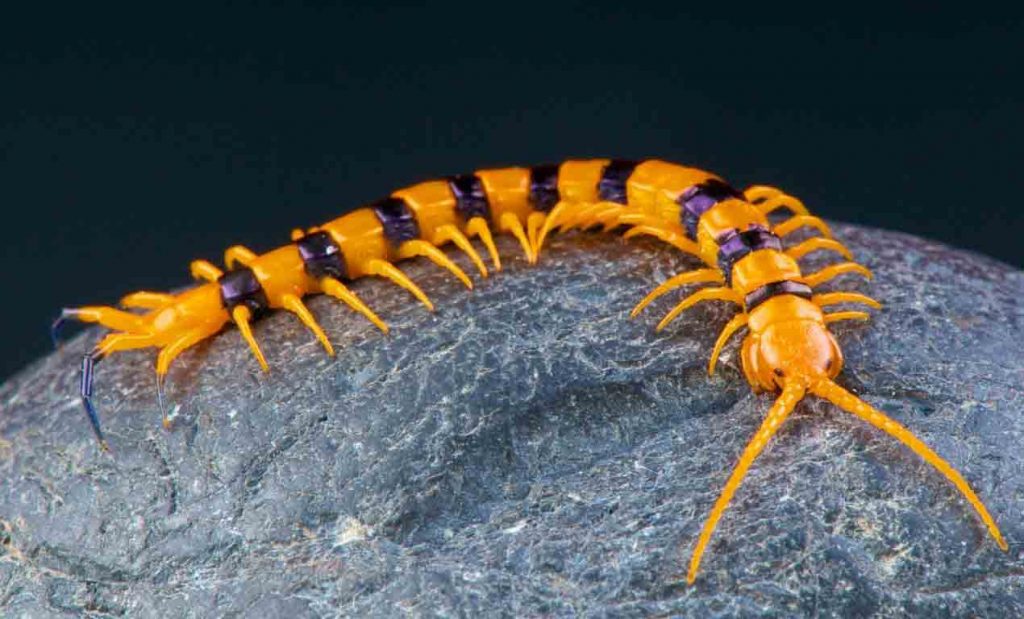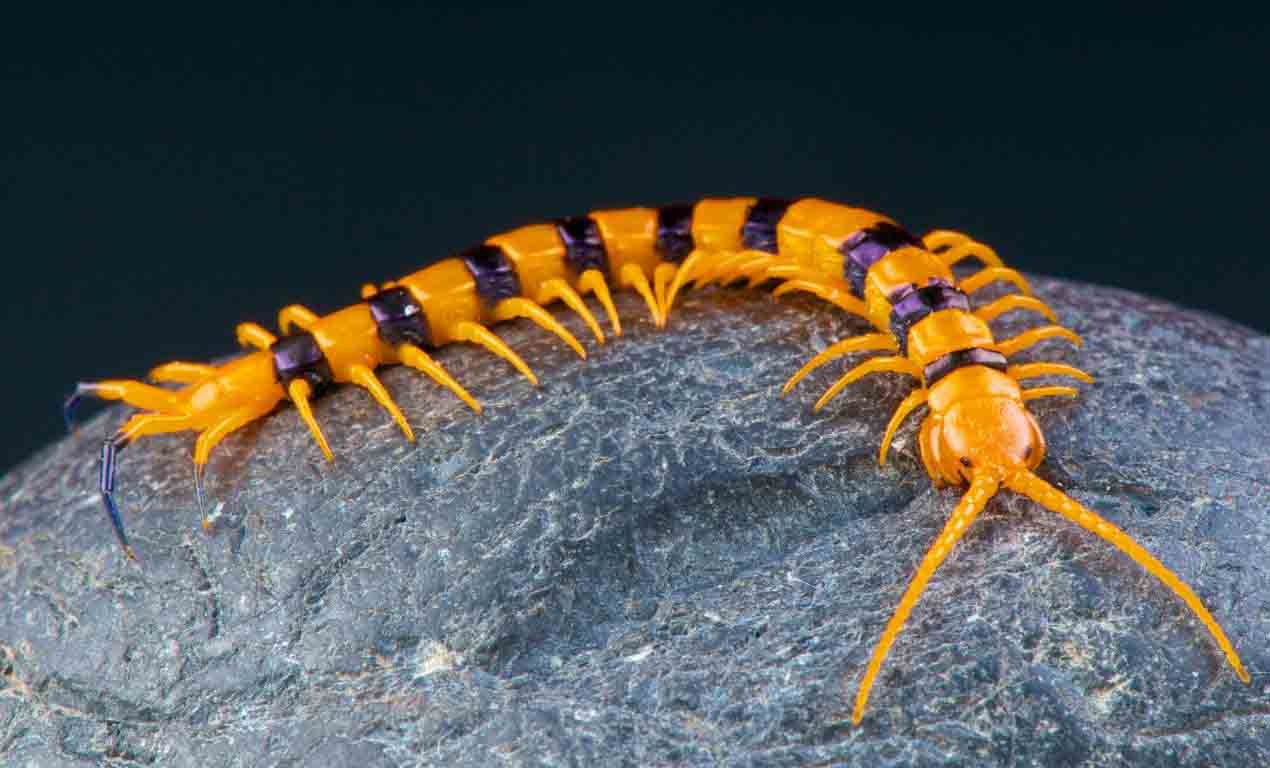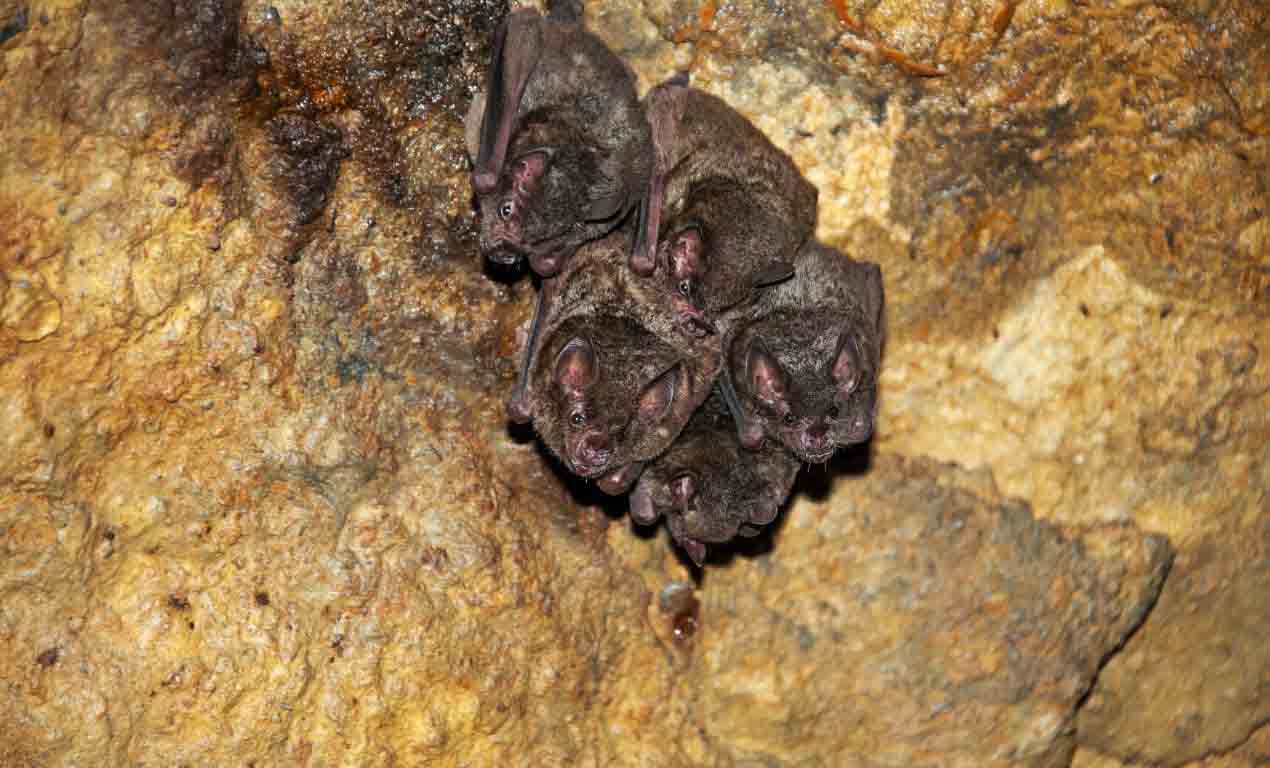
 Scolopendra gigantea is one of the enormous centipedes found in South America and the Caribbeans. They are also known as an Amazonian giant centipede or the Peruvian giant yellow leg centipede. They usually are around 12 inches in length. They feed on a wide variety of animals, including some larger arthropods, amphibians, reptiles, and mammals.
Scolopendra gigantea is one of the enormous centipedes found in South America and the Caribbeans. They are also known as an Amazonian giant centipede or the Peruvian giant yellow leg centipede. They usually are around 12 inches in length. They feed on a wide variety of animals, including some larger arthropods, amphibians, reptiles, and mammals.
So, can scolopendra gigantea eat bat? Yes, they can. In fact they do it quite often. These centipedes are big and they catch the bat by surprise and then they inject their poison which paralyzes them and then the giant centipede eats them.
Keep reading to know it in details.
Behavior And Diet
It is a carnivore and feeds on other animals. Depending upon the size of its prey, it strategizes its attacks suitably. In addition to feeding on giant insects, millipedes, scorpions, and tarantulas, they also feed on small vertebrates like the frog, snakes, mice, and even bats. Concerning bats, scolopendra gigantea climbs the cave walls and manipulates the bats, with just a few legs holding on to the roof of the cave.
Description
Centipedes have rounded and flathead, having a pair of antennae in the front. They have a couple of elongated mandibles and two pairs of maxillae. The first pair of limbs extends and covers its mouth. These legs end with sharp claws. These claws have venom glands, which paralyzes its prey.
Most specimens of centipedes lack eyes. Some have ocelli, but they hardly have a vision and can only discern between light and shade. On the underside of their antennas, there are sensory cells, which can detect vibration and maybe a sense of hearing.
Forcipules are found only in centipede. We see this pincer-like appendage on their first pair of legs, which ends in sharp claws. The venom gland runs thro’ a tube to the end of each claw.
The centipedes have fifteen or more segments behind the head. The last two sections are smaller and don’t carry any legs. Every pair of legs gets more extended than the one in front. The final segment has the reproductive part, which is known as telson.
They use their antennas to seek out their prey. Have a simple digestive system, and the digestive glands are attached to their mouthparts. Like insects, centipedes breathe thro’ tracheal system, with a small opening or spiracle, present on each body segment. Malpighian tubules get used to excrete waste.
Lifecycle
Centipedes do not copulate for reproduction. Males leave their sperm for the females to find them. Some male species entice the females to their sperm. The females swallow them, and once fertilization takes place, eggs get hatched.
Centipedes usually lay their eggs in the soil and other moist places and cover them with foliages. Some species guard them till they hatch. 10 to 50 eggs get laid by the females. Hatching of the eggs may vary from one to few months.
Adult centipedes can live between five to ten years, depending upon the species.
Ecology
Centipedes hardly feed on vegetable matter. They prey on organic matter, and they feed on all types of insects, reptiles, small animals, and amphibians. Their defense mechanism is their claws, venom, and speed.
Since their exoskeleton is devoid of wax, they lose water quickly. Also, their excreta contain ammonia, which requires water to react with nitrogen. Hence they prefer moist surroundings to survive.
Centipedes continue to molt during their adulthood. In case they lose some legs to a predator, they are seen growing new legs. They are mostly nocturnal creatures and prefer darkness to sunshine.
Habitat
Centipedes prefer to live in moist, damp places. They usually live outdoors, under the boulder, inside the soil, under the fallen tree or garbage dump, which attracts lots of insects, which they feed on.
Respiratory System
Centipedes have a tracheal tube respiratory system to breathe. This has several parts.
Spiracles:They are openings on the exoskeleton, thro’ which the air enters the body of a centipede. They have this opening in most of the segments. The anterior and few posterior segments lack these opening
Trachea:This collected air gets sent to their many tracheas. This trachea delivers the air from outside to its various parts.
Tracheoles:Some of the air get also sent to their much smaller tracheoles, which get connected to individual cells.
The scolopendra gigantea are red-maroon with forty-six yellow-tinted legs. They are swift runners and can quickly climb any surface of the walls, including the wet caves. They can reach any part of the ceiling, and their multiple legs support them in hanging, holding, and foiling their prey.
Bats
 Bats comprise 20% of mammal species worldwide and are the most significant order after rodents. They have around 1,200 species. The above megabats or flying foxes are part of this extended family. You also have the microbats. Now, the classification of bats is as follows: Yinpterochiropetra and Yangochiropetra.
Bats comprise 20% of mammal species worldwide and are the most significant order after rodents. They have around 1,200 species. The above megabats or flying foxes are part of this extended family. You also have the microbats. Now, the classification of bats is as follows: Yinpterochiropetra and Yangochiropetra.
Megabats and few microbats are part of Yinpterochiropetra. The rest of the tribe of bats is Yangochiropetra. Along with eating fruits and nuts, bats feed on insects and in some rare varieties of animals and birds. Vampire bats are known the world over, to feed on blood. Microbats are also known as small bats, insectivorous bats, or echolocating bats.
Bats are generally known to be dark and evil, attracting witchcraft, vampires, blood, and death. Their dung gets the stamp of super fertilizer in certain regions. Their sheer numbers attract tourists at their abodes across the world.
Description
Characteristics:Microbats are 4 to 16cm long on an average. They usually feed on insects. Larger species hunts birds, frogs, lizards, smaller bats, and even fish. Only three species of microbats feed on the blood of mammals or birds. These bats use echolocation to spot their prey.
Body and dentition:They don’t have the claw in their foreleg. The ears of microbats have a tragus, which helps them with echolocation. Microbats have comparatively smaller eyes. Since these bats eat all kinds of insects, birds, animals and also suck blood, each species have a different dental structure. They have smaller heads, and the jaw structure varies as per their feeding requirement.
Wings:Bats’ wings are much stronger compared to birds since they travel extensively. They have more bones in their arms, and the thin membrane gets tightly stretched on the bony frame. The muscles on their body, where the wings get attached, are very powerful.
Roosting:When they don’t fly, they hang by their feet from their perch. This is called roosting
Internal System
They have a robust respiratory and circulatory system. The digestive system differs as per the food habits of that species. The kidney function and the uterine system vary between bats.
Senses
Echolocation:This is a distinct way; microbats can create a mental image of the location of their prey and also their terrain of flight. Bats generate ultrasound thro’ their larynx, which gets emitted from their mouth or nose. They listen to the echo of this sound, basis which they form images of their surroundings.
Vision:They have small eyes and poor vision. They can detect poor light and only for a short distance since they have a mesopic vision.
Magnetoreception:Bats are sensitive to the earth’s magnetic field and can orient themselves concerning the direction of their flight.
Thermoregulation:Most bats are homeothermic, which is having a stable temperature. Since their dark wings absorb the sun’s radiation, they avoid flying out during the day.
Torpor:This is the relaxing activity of bats during the day. This is very useful for microbats, who are super active at night. They get into hibernation mode during winter, too, with minimum activities.
Food
Most of them, around 70%, feed on all kinds of insects. Some bats prey on other vertebrates, like lizards, frogs, fish, and mammals. A few species, white-winged and hairy-legged vampire bats feed on blood only.
Infection
A large number of microbats fall prey to white-nose syndrome, which is a type of fatal fungal infection.
Breeding
Microbats prefer cave walls to build their colonies in thousands. Females create their nursing colonies where the pup is taken care of by them for six to eight weeks.
Scolopendra Gigantea And Bats
Bats are known to be attacked by various predators, including spiders and centipedes. Let’s look at how the scolopendra gigantea attack their prey:
- Scolopendragigantea, living in the Peruvian jungle and the Amazon rain forest, get considered as most ferocious and aggressive when they encounter any victim that comes their way.
- They use their antenna to seek out their prey.
- In the case of bats, these centipedes climb the cave walls and attack the bats, who are in deep slumber during the day.
- They use their forcipules to latch on their prey and inject the venom, present at the edge of their claw.
- As soon as their prey succumbs to paralytic venom, the centipede commences feeding on the flesh of the bat.
- These centipedes can hold on to the cave surface with their rear legs and continue feeding on the dangling bat in mid-air.
- They also hang from the center of dark caves, waiting for a passing bat.
- As soon an unsuspecting bat brushes past, the centipede latches quickly with its front legs and the forcipule.
- The pierced claws inject the venom, which quickly paralyzes the bat.
- Holding on to the bat with its multiple front legs, the quickly commences feeding on the bat.
- In about an hour, the entire organic matter of the bat gets devoured. All this happens with the scolopendra gigantea dangling from the ceiling.
- After a sumptuous meal, they return to their dark corner of the cave, completed sated.
Conclusion
Though bats are much larger than scolopendra gigantea, they succumb to these aggressive centipedes, which dwells in the dark corners of their caves.
Welcome to my blog. I have been doing pest control for years since my house, garden and pets were always attacked by various kinds of pests and as a result I had to know proper pest control techniques that works. In this blog I share all the tips and tricks that I know and I hope you’ll find it helpful.
